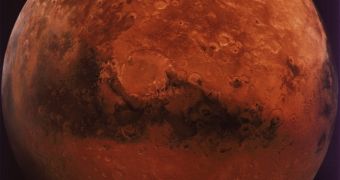Following the resounding success of the Mars Phoenix Lander's mission, its three main project leaders were invited to New York's Popular Mechanics' Breakthrough conference in order to shed more light on the gathered data and on what future similar missions may expect to discover.
The mission of NASA's first Mars Lander, Phoenix, was originally scheduled to last for three months, but surprisingly, the lander achieved double mission length. During its inquiring visit to the red planet, it discovered ice just inches under its surface and snow in the clouds. Also, the pH of the soil on Mars was calculated to be approximately the same as the one of the Earth oceans - between 8 and 8.5. Even more, the perchlorate found in the soil opened doors for the possibility of life existence, since Earth holds some microorganisms that draw their energy from organic salt. Sadly, the Sun doesn't provide enough energy in order to keep the probe functioning and the amounts it received by the 90th Martian day provides clues according to which the lander will cease activity and freeze by the end of this month. But before doing so, it will attempt to activate a microphone that would provide the first sounds from the surface of Mars.
The lander revealed a fault in NASA's calculations based on the previous knowledge of the atmosphere from Mars (the experts shifted its landing course by a degree, causing it to land quite far from the estimated landing point, although still in the landing area). Of course, as the leaders of the project, Barry Goldstein from NASA's Jet Propulsion Laboratory, Peter Smith, the science leader of the project from the University of Arizona, and Ed Sedivy of Lockheed Martin Space Systems, admit, the mission also raised as many questions as it provided answers. Smith wonders how deep the Martian ice layer is, “Is it 10 feet? 100 feet? 1.000 feet? Who knows?”. At the same time, Sedivy is curious about “Where did that atmosphere go, and why?”. Perhaps future missions like the MAVEN project that is currently discussed will be able to determine that more precisely. In any case, the Moon will be first visited as a training ground for future manned missions to our red neighbor.

 14 DAY TRIAL //
14 DAY TRIAL //